Abstract
Purpose
To evaluate the accuracy of intraocular lens (IOL) power calculations according to the chosen formulas and anterior chamber depths in eyes with short axial lengths.
Methods
A retrospective analysis was performed on 57 eyes of 50 patients (axial length < 22.0 mm) and 42 eyes of 36 patients (22.0 mm ≤ axial length < 25.0 mm) who underwent cataract surgery. IOL power was calculated with the SRK II, SRK/T, Binkhorst, Holladay I, and Hoffer Q formulas. The differences between the predicted refraction and the actual refraction were compared and analyzed. The errors according to the anterior chamber depth were also evaluated.
Results
The SRK II formula showed a lower predictive accuracy, and the other formulas showed similar accuracies in eyes with short axial lengths. The Holladay 1 and Hoffer Q formulas showed good predictive accuracies in eyes with short axial lengths. Hyperopic shift tended to occur with all formulas in eyes with short axial lengths. When using SRK II and SRK/T formulas, a correlation between axial length and hyperopic shift was observed, with shorter axial length patients shifting to more hyperopic conditions. In eyes with short axial lengths, larger hyperopic shifts tended to occur in eyes with relatively deeper anterior chambers.
References
1. Drexler W, Findl O, Menapace R, et al. Partial coherence interferometry: a novel approach to biometry in cataract surgery. Am J Ophthalmol. 1998; 126:524–34.

2. Holladay JT, Gills JP, Leidlin J, Cherchio M. Achieving emmetropia in extremely short eyes with two piggyback posterior chamber intraocular lenses. Ophthalmology. 1996; 103:1118–23.

3. Olsen T, Corydon L, Gimbel H. Intraocular lens power calculation with an improved anterior chamber depth prediction algorithm. J Cataract Refract Surg. 1995; 21:313–19.

4. Drews RC. Reliability of lens implant power formulas in hyper-opes and myopes. Ophthalmic Surg. 1988; 19:11–5.

5. MacLaren RE, Sagoo MS, Restori M, Allan BDS. Biometry accuracy using zero or negative powered intraocular lenses. J Cataract Refract Surg. 2005; 31:280–90.
6. Hoffer KJ. The Hoffer Q formala: a comparison of theoretic and regression formulas. J Cataract Refract Surg. 1993; 19:700–12. Errata, 1994;20:677.
7. Coburn RM, Grandon SC, Grandon GM. Intraocular lens implant power calculations: Investigation controlling for lens type. J Cataract Refract Surg. 1990; 16:457–64.
8. Richards SC, Steen DW. Clinical evaluation of the Holladay and SRK II formulas. J Cataract Refract Surg. 1990; 16:71–4.

9. Cho YT, Lee EH. Evaluation for the accuracy of the SRK/T formula in PCL implanted patients(I). J Korean Ophthalmol Soc. 1991; 32:752–60.
10. Park HS, Yang KJ. Comparison of the Hoffer Q and SRK-II formulas in IOL power calculation. J Korean Ophthalmol Soc. 1995; 36:399–405.
11. Narvaez J, Zimmerman G, Stulting D, Chang DH. Accuracy of intraocular lens power prediction using the Hoffer Q, Holladay 1, Holladay 2, and SRK/T formulas. J Cataract Refract Surg. 2006; 32:2050–3.
12. Olsen T. Sources of error in intraocular lens power calculation. J Cataract Refract Surg. 1992; 18:125–9.

13. Maeng HS, Ryu EH, Chung TY, Chung ES. Effect of anterior chamber depth and axial length on refractive error after intraocular lens implantation. J Korean Ophthalmol Soc. 2010; 51:195–202.
14. MacLaren RE, Natkunarajah M, Riaz Y, et al. Biometry and formula accuracy with intraocular lenses used for cataract surgery in extreme hyperopia. Am J Ophthalmol. 2007; 143:920–31.

15. Lee WJ, Yoon GS, Hong NS, Shyn KH. A study for measurement of the anterior chamber depth and angle using image analysis technique in cataractous eyes. J Korean Ophthalmol Soc. 1996; 37:70–7.
Figure 1.
Correlation between axial length and accuracy of intraocular lens power calculation with SRK II formula There is positive correlation between axial lengths and numerical predictive errors with SRK II. *PE = predictive error; †R2 = Pearson's correlation coefficient.
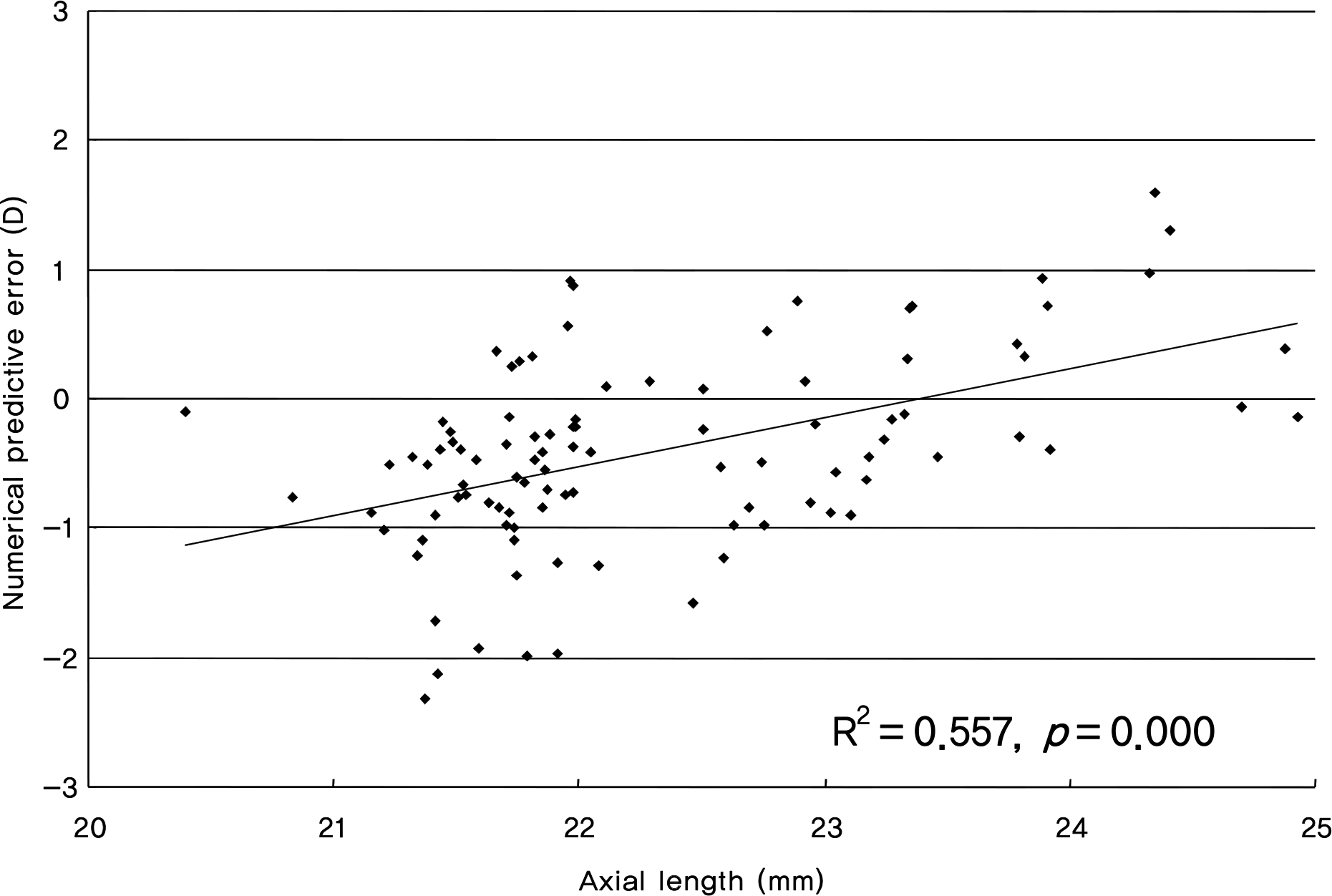
Figure 2.
Correlation between axial length and accuracy of intraocular lens power calculation with SRK/T formula There was positive correlation between axial lengths and numerical predictive errors with SRK/T. *PE = predictive error; †R2 = Pearson's correlation coefficient.
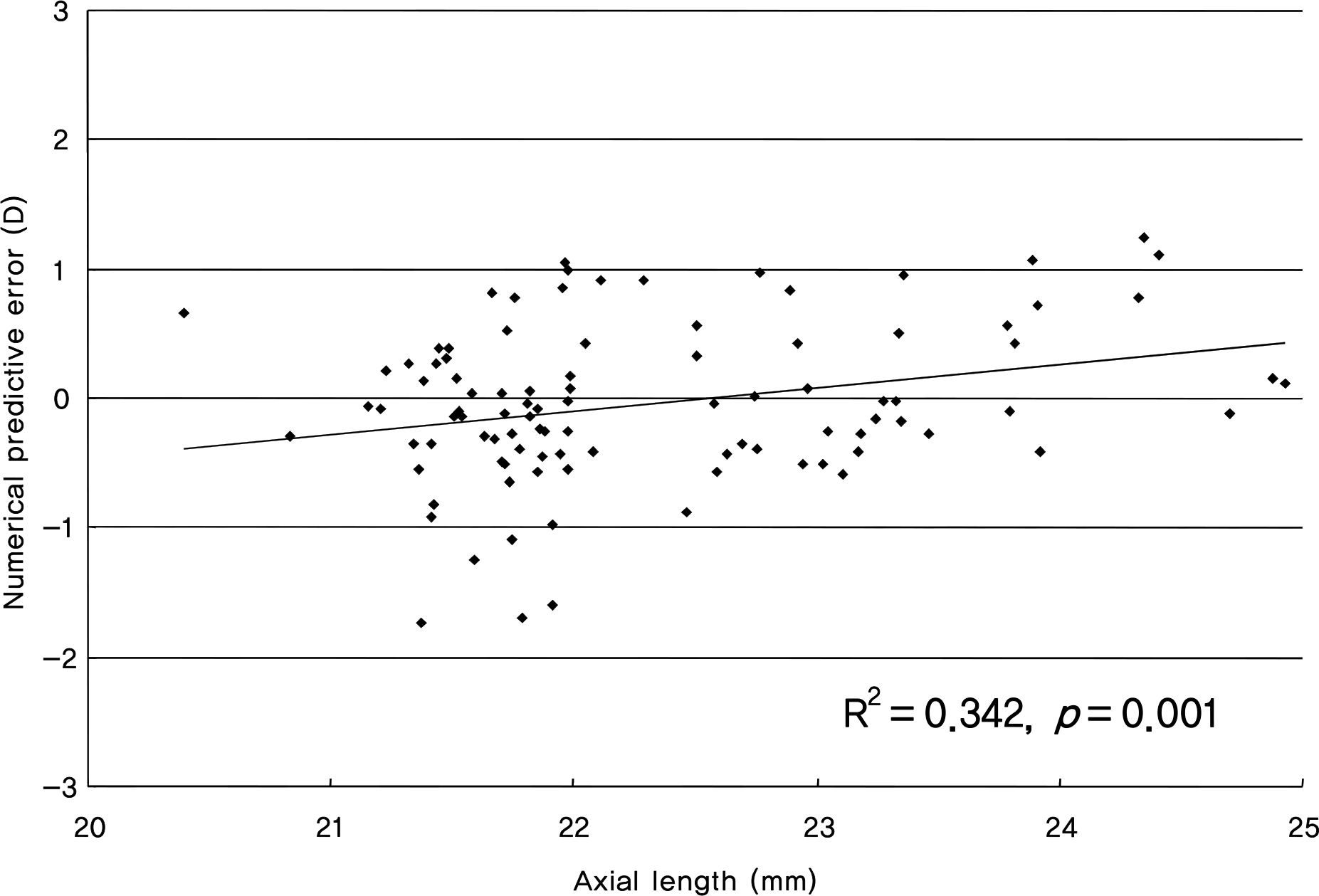
Figure 3.
Correlation between axial length and accuracy of intraocular lens power calculation with Binkhorst formula There was no correlation between axial lengths and predictive errors with Binkhorst. *PE = predictive error; †R2 = Pearson's correlation coefficient.
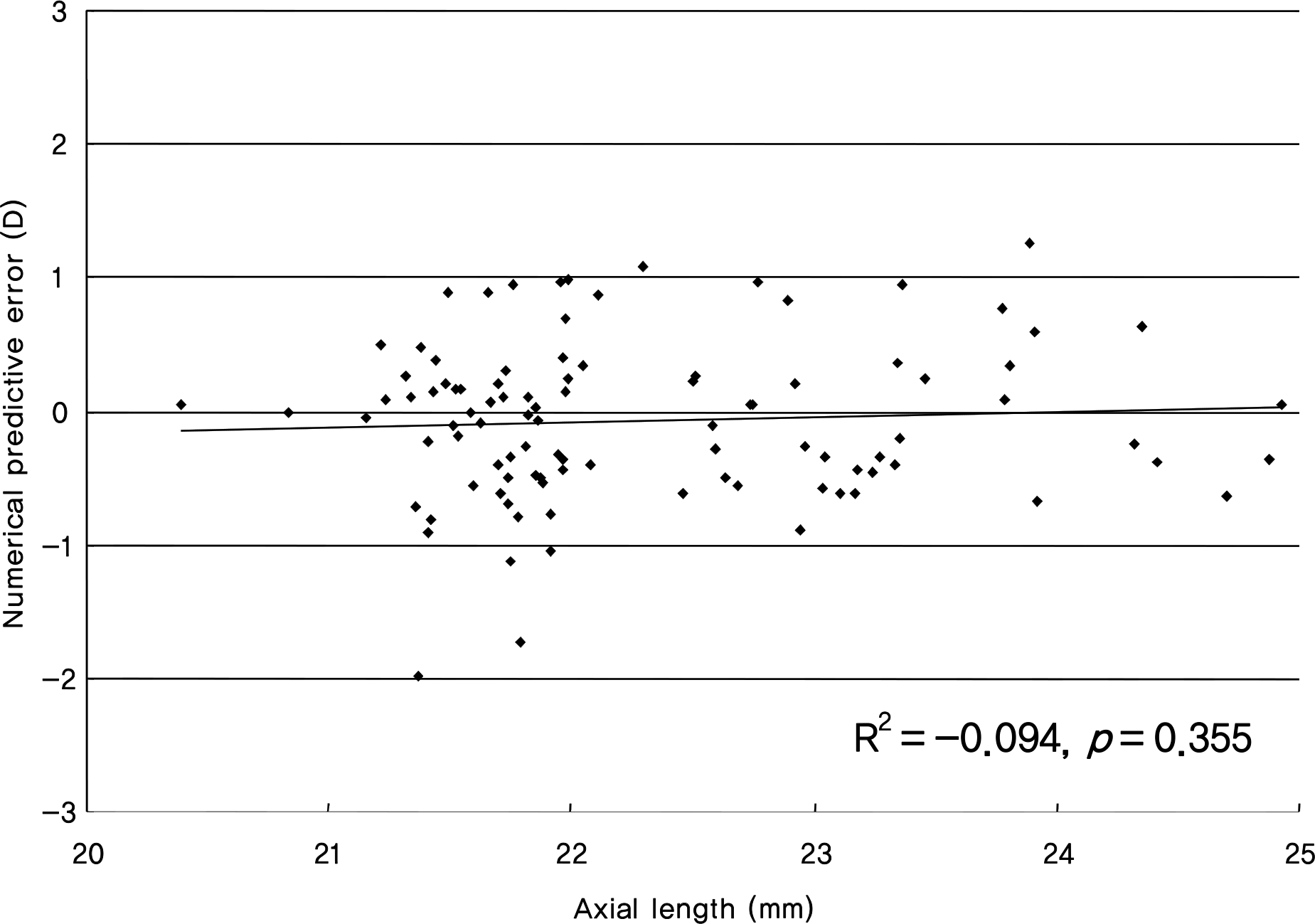
Figure 4.
Correlation between axial length and accuracy of intraocular lens power calculation with Holladay I formula. There was no correlation between axial lengths and predictive errors with Holladay I. *PE = predictive error; †R2 = Pearson's correlation coefficient.
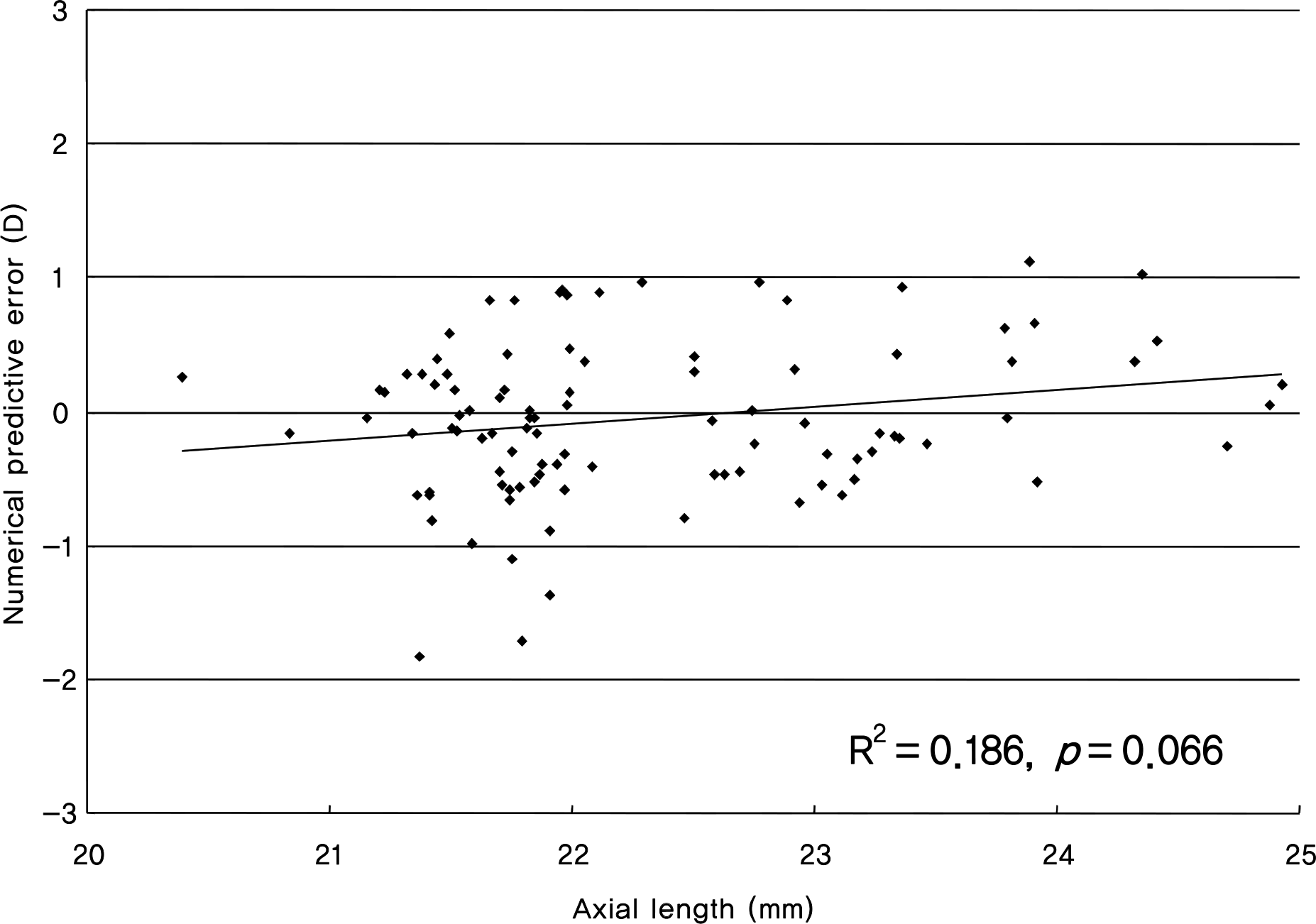
Figure 5.
Correlation between axial length and accuracy of intraocular lens power calculation with Hoffer Q formula. There was no correlation between axial lengths and predictive errors with Hoffer Q. *PE = predictive error; †R2 = Pearson's correlation coefficient.
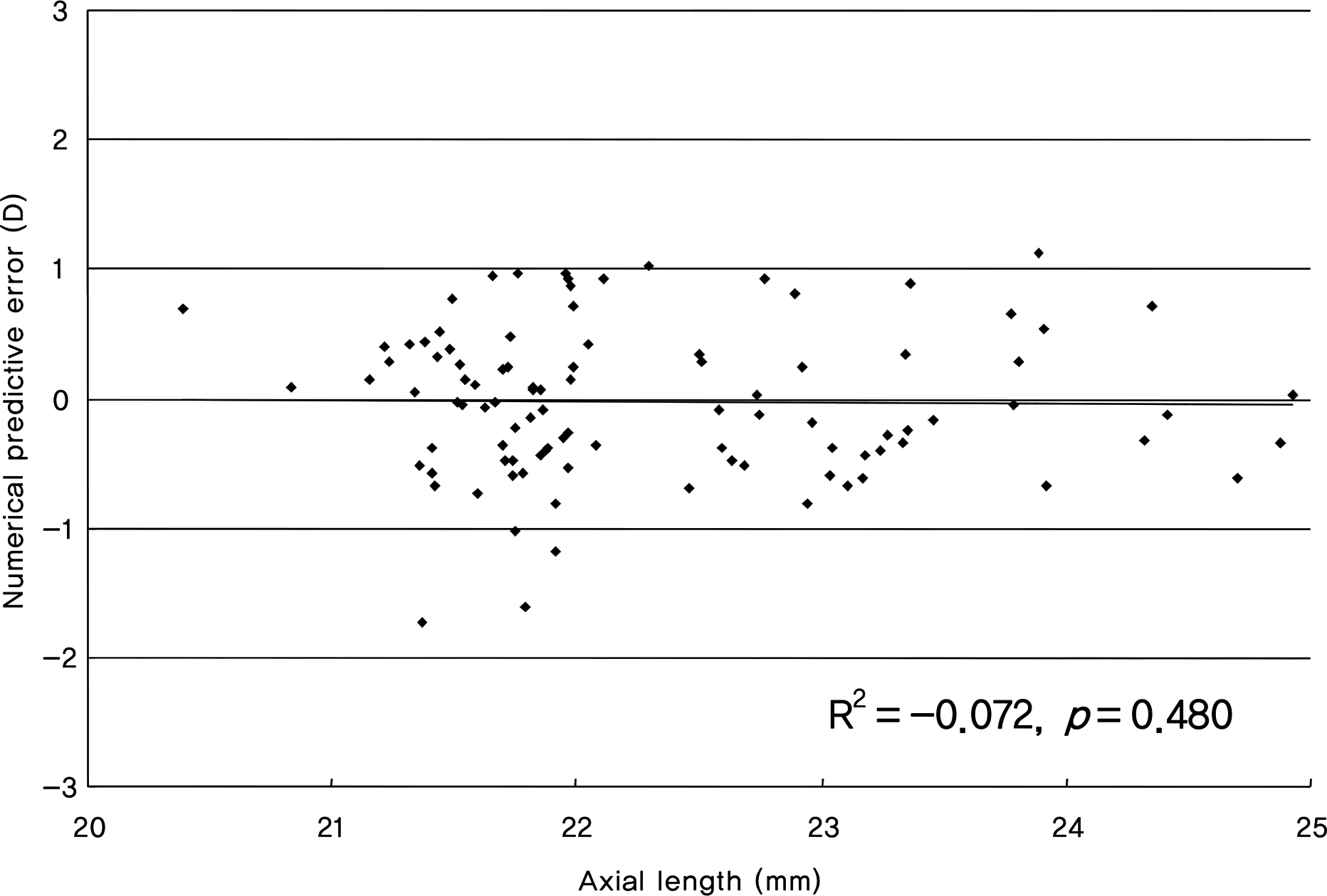
Table 1.
Preoperative demographics, preoperative biometry and implanted intraocular lens power
| Parameters | Group I (AL* < 22 mm) | Group II (22 mm ≤ AL < 25 mm) | p value |
|---|---|---|---|
| No. of eyes | 57 | 42 | |
| Age (years) | 69.8 ± 3.2 | 67.4 ± 8.0 | 0.148 |
| Sex (M/F) | 2/48 | 1/35 | |
| Nucleus opacity score (LOCS† III) | 2.2 ± 0.9 | 1.9 ± 0.8 | 0.075 |
| Keratometry (D) | 45.53 ± 1.07 | 44.50 ± 0.99 | 0.000 |
| Anterior chamber depth (mm) | 2.26 ± 0.35 | 2.83 ± 0.52 | 0.000 |
| Axial length (mm) | 21.63 ± 0.30 | 23.24 ± 0.75 | 0.000 |
| IOL‡ power (D) | 25.66 ± 1.05 | 21.61 ± 1.81 | 0.000 |
Table 2.
Mean absolute predictive error and numerical predictive error according to intraocular lens power calculation formulas
| IOL* formula | | Mean absolute error (D) | Mean numerical error (D) |
|---|---|---|---|
| SRK II | I | 0.73 ± 0.53† | −0.63 ± 0.68 |
| | II | 0.59 ± 0.41 | −0.11 ± 0.72 |
| SRK/T | I | 0.47 ± 0.42 | −0.18 ± 0.61 |
| | II | 0.48 ± 0.34 | 0.15 ± 0.57 |
| Binkhorst | I | 0.46 ± 0.42 | −0.13 ± 0.61 |
| | II | 0.48 ± 0.30 | 0.01 ± 0.57 |
| Holladay I | I | 0.46 ± 0.41 | −0.16 ± 0.59 |
| | II | 0.46 ± 0.29 | 0.08 ± 0.54 |
| Hoffer Q | I | 0.47 ± 0.38 | −0.05 ± 0.60 |
| | II | 0.46 ± 0.29 | −0.01 ± 0.55 |
Table 3.
Percentage of cases predicted to within ±0.5D, ±1.0D and over +1.0D using different intraocular lens calculation formulas
| IOL* formula | |
Percentage of error predicted (%) |
||
|---|---|---|---|---|
| <0.5D | <1.0D | >1.0D | ||
| SRK II | I | 40.4 | 78.9 | 22.8† |
| II | 50.0 | 88.1 | 7.1 | |
| SRK/T | I | 64.9 | 87.7 | 8.8† |
| II | 57.1 | 92.9 | 0 | |
| Binkhorst | I | 66.7 | 93.0 | 7.0† |
| II | 59.7 | 95.2 | 0 | |
| Holladay I | I | 61.4 | 93.0 | 7.0† |
| II | 61.9 | 95.2 | 0 | |
| Hoffer Q | I | 63.2 | 91.2 | 7.0† |
| II | 59.5 | 95.2 | 0 | |
Table 4.
Mean absolute predictive error and numerical predictive error according to intraocular lens power calculation formulas and anterior chamber depth (Group i: anterior chamber depth <2.26 mm; Group ii: 2.26 mm ≤ anterior chamber depth)
| IOL* formula | | Mean absolute error (D) | Mean numerical error (D) |
|---|---|---|---|
| SRK II | i | 0.70 ± 0.57 | −0.64 ± 0.64 |
| ii | 0.81 ± 0.48 | −0.62 ± 0.73 | |
| SRK/T | i | 0.45 ± 0.44 | −0.16 ± 0.62 |
| ii | 0.49 ± 0.41 | −0.21 ± 0.61 | |
| Binkhorst | i | 0.42 ± 0.42 | −0.05 ± 0.58 |
| ii | 0.51 ± 0.40 | −0.21 ± 0.64 | |
| Holladay I | i | 0.42 ± 0.42 | −0.12 ± 0.58 |
| ii | 0.51 ± 0.40 | −0.21 ± 0.62 | |
| Hoffer Q | i | 0.44 ± 0.38 | 0.01 ± 0.59 |
| ii | 0.50 ± 0.29 | −0.11 ± 0.62 |




 PDF
PDF ePub
ePub Citation
Citation Print
Print


 XML Download
XML Download